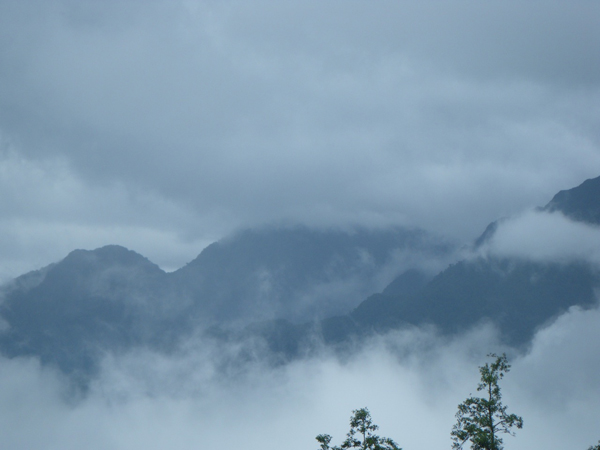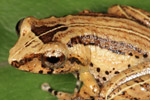A team of Australian and Vietnamese researchers recently discovered a new species of frog in the high elevations of Vietnam’s Mount Fansipan, according to a new paper in Zootaxa. The amphibian was named Botsford’s leaf-litter frog (Leptolalax botsfordi) as a tribute to Christopher Botsford for his role in amphibian biodiversity research in Asia.
“I had a pretty good idea that the species was undescribed the moment I heard its faint chirp,” Jodi Rowley of the Australian Museum Research Institute told mongabay.com.
One characteristic shared by other Asian leaf-litter frog species is that they make noises similar to insects, but the calls of this new species are unique. While Rowley’s colleagues found many frog species in the stream, Rowley spent hours in the fog filled night sifting through the leaves in one spot trying to find the unknown frog. The moment she finally located the frog, she was filled with a sense of triumph.
 Leptolalax botsfordi. Photo by Jodi Rowley.
Leptolalax botsfordi. Photo by Jodi Rowley.
The genus Leptolalax is a group of small-bodied frogs whose true biodiversity has only started gaining appreciation in the last five years due to increased exploration and improvements in acoustic and molecular data analysis. Despite being scientifically classified as frogs, they are sometimes referred to as toads due to their bumpy skin. This particular species is more vigorous than other Asian leaf-litter frogs, and has a distinct brownish-pink belly and huge white glands on its thighs.
 Team members at Mount Fansipan Basecamp. Photo by Jodi Rowley. |
Although Mount Fansipan hosts many overnight tourists attempting to summit “the roof of Indochina,” relatively little is known about its flora and fauna. Earlier in 2013, scientists in Fansipan described the Sterling’s toothed toad (Oreolalax sterlingae) which, similarly to the Botsford’s leaf-litter frog, is also technically a frog from the Megophryidae family.
Rowley says that she and her colleagues plan to continue working in Vietnam to gather as much information as possible about the amphibians and their conservation status.
“With the discovery of Botsford’s Asian leaf-litter toad, and Sterling’s toothed toad from the same high-elevation stream… it’s clear that the area is important for amphibian conservation,” said Rowley.
Clouds and fog fill Mount Fansipan. Despite being a heavily visited area by tourists, this rough environment has seen little biological research.

Leptolalax botsfordi. Photo by Jodi Rowley.

Mount Fansipan. Photo by Jodi Rowley.
Citations:
- Rowley et al (2013). A new species of Leptolalax (Anura: Megophryidae) from the highest mountain in Indochina. Zootaxa 3737 (4): 415–428 http://dx.doi.org/10.11646/zootaxa.3737.4.5
- Nguyen et al (2013). First Record of the Genus Oreolalax (Anura: Megophryidae) from Vietnam with Description of a New Species. Copeia 2013 (2): 213-222 http://dx.doi.org/10.1643/CH-12-021
Related articles
High-living frogs hurt by remote oil roads in the Amazon

(01/14/2014) Often touted as low-impact, remote oil roads in the Amazon are, in fact, having a large impact on frogs living in flowers in the upper canopy, according to a new paper published in PLOS ONE. In Ecuador’s Yasuni National Park, massive bromeliads grow on tall tropical trees high in the canopy and may contain up to four liters of standing water. Lounging inside this micro-pools, researchers find a wide diversity of life, including various species of frogs. However, despite these frogs living as high as 50 meters above the forest floor, a new study finds that proximity to oil roads actually decreases the populations of high-living frogs.
Not seen in over 130 years, ‘extinct’ frog rediscovered in Sri Lanka

(01/10/2014) In 1876—the same year that the first telephone call was made—the British scientist Albert Günther described a new species of frog from Sri Lanka, but the species, known as the webless shrub frog (Pseudophilautus hypomelas), was never seen again. Having disappeared into history, scientists considered the species extinct—that is until a 2010 expedition stumbled on 40 mystery frogs.
Sky islands: exploring East Africa’s last frontier
,-South-Pare-Mts.-Tanzania.150.jpg)
(12/04/2013) The montane rainforests of East Africa are little-known to the global public. The Amazon and Congo loom much larger in our minds, while the savannas of East Africa remain the iconic ecosystems for the region. However these ancient, biodiverse forests—sitting on the tops of mountains rising from the African savanna—are home to some remarkable species, many found only in a single forest. A team of international scientists—Michele Menegon, Fabio Pupin, and Simon Loader—have made it their mission to document the little-known reptiles and amphibians in these so-called sky islands, many of which are highly imperiled.
Microhabitats could buffer some rainforest animals against climate change
(11/25/2013) As temperatures increase worldwide due to anthropogenic climate change, scientists are scrambling to figure out if species will be able to survive rapidly warming ecosystems. A new study in Global Change Biology offers a little hope. Studying reptiles and amphibians in the Philippines, scientists say some of these species may be able to seek refuge in cooler microhabitats, such as tree holes or under the soil, in order to stay alive during intensifying heatwaves. But, the scientists’ stress, the shelter from microhabitats can only protect so far.